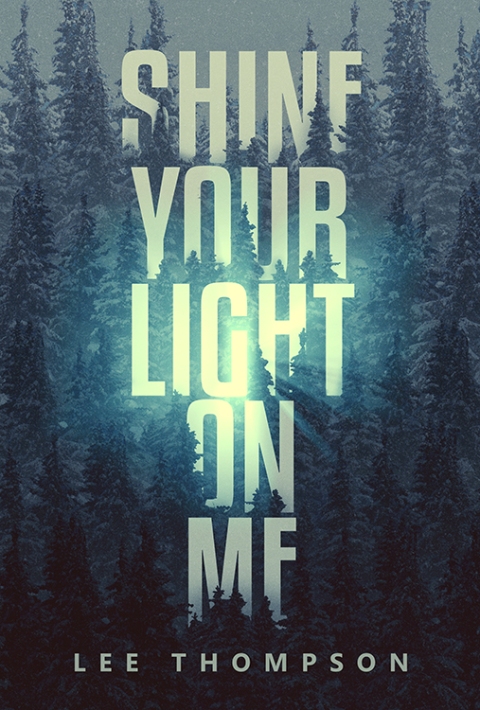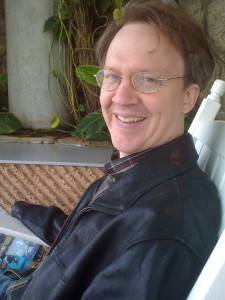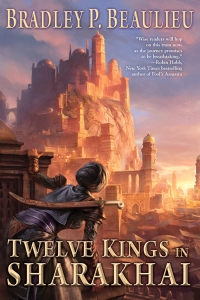Archive for the ‘interviews’ Category
- In: interviews | John Adcox
- 4 Comments
Hey, so my WordPress Editor just an hour ago spontaniously switched to the Block Editor. which means I have NO IDEA how this post is going to turn out, because everything is super weird.
I met John on Twitter a while back, and we’ve chatted back and forth a few times. He’s a fellow science fiction and fantasy fan, a writer who loves mythology, a writer who seeks out wonder.
What started off as a project between friends, for their family, has turned into something much, much more. Several years ago, John and his wife Carol started a tradition of creating a Christmas book for their friends and family, with John writing the prose, and Carol doing the illustrations. These stories are now ready to shared with everyone, and every year, starting in 2020, Story Plant will publish one of John and Carol’s books. The first one, Raven Wakes the World, hits bookstore shelves next week. (Indiebound ordering link)
A tale of an artist rediscovering her own strength, Raven Wakes the World is a magical realism with a touch of romance, and the unforgiving environs of Alaska. If you are looking for a unique holiday gift for someone who loves modern mythology, this could be it! Click here to read a free preview.
You can learn more about John and his work at his website, JohnAdcox.com, and by following him on twitter, where he is @JohnAdcox.
ok, so funny story – when I emailed John these questions, I knew the illustrator’s name was Carol, I didn’t know that was THE Carol, John’s wife! That’s what I get for not doing my research, that’s for sure!

Little Red Reviewer: Congrats on your new novella, Raven Wakes the World! What inspired you to write this book?
John Adcox: That’s hard to answer. I’ve always had a fascination with mythology, and I love stories where myth bleeds out to enchant and maybe even heal our own more mundane world. I truly do believe that stories have the power to change and heal us. Sometimes, story might be the only thing that does. Not too long ago, I heard a pastor friend define religion as communal response to a story. Why not? After all, the language of God is parable and story. I think other people’s stories might have a power to reach us in a way that our own, more familiar ones can’t. And it’s telling, I think, that so many of our most sacred stories have echoes in cultures all around the world. The inspiration, I think, was to look at Christmas, and healing or rebirth, through a different cultural lens.
LRR: Tell about this story – what’s the elevator pitch?
JA: Katie Mason is an artist wounded in the soul after the end of a broken relationship. She’s fled all the way to Alaska to heal and to make art, but she hasn’t been able to do either. She’s cocooned herself, like the world in winter. But in the town of Aurora, Alaska, she meets a mysterious stranger who wakes her passions, and who has secrets. Soon she finds herself caught in an Inuit myth made real, and in a world where winter seems to last forever. If you’d like to know more, the opening chapters are online at http://ravenwakestheworld.com/.
What was your favorite scene to write in Raven Wakes the World? Where there any scenes that were unexpectedly difficult to write?
J.A.:Wow, that’s also really hard to answer! I think my favorite scene is the one where Katie first hears the story about how Raven stole the sun, the moon, and the stars and brought light to the dark world. It’s also the scene that inspired my favorite of the illustrations. The hardest to write, I think, was the end, when Katie faces her pain and starts to make hard choices. It’s always hard to write about pain and heartbreak. Sacrifice isn’t especially easy either, especially when it is for love.
LRR: I read on your blog that you and your wife have a family tradition of creating original Christmas stories. How did the tradition get started? Has it changed over the years? What are the elements that all Christmas stories must have, to be a good holiday story?
J.A.:My friend Carol Bales — she wasn’t my beloved wife yet; we weren’t even dating back then — and I had the idea to collaborate on a book to give our friends as a Christmas gift. I’d write a story and she’d draw the illustrations. We bound those first books by hand. People seemed to really like them. Raven Wakes the World was the first of them … although this version is extensively revised and expanded. Over the following years, we tried a number of different genres, including drama, an urban legend/ghost story, action/adventure, and even screwball romantic comedy. If there’s a connection between these books (aside from the fact that they take place in winter, which is absolutely my favorite season to write) it’s has to do with people who are somehow isolated and hurting, and who find their way back to home, family, community, and joy. Christmas is about birth and rebirth, and homecoming, and that seems almost universal in so many cultures. I think all of these stories have to do with people who are broken finding a way to be less broken, sometimes through a miracle. I’m not sure that’s true of all Christmas or holiday tales, but it’s certainly true of a lot of them, from A Christmas Carol to Rudolf the Red-nosed Reindeer and How the Grinch Stole Christmas.

I recently had the opportunity to interview author Howard Andrew Jones, whose forthcoming fantasy book, For The Killing of Kings, will be available in February from St. Martin’s press. The first in an epic, adventure-filled trilogy, For The Killing of Kings involves a fragile peace, forgeries, conspiracies, and a near unstoppable invading force. Brace yourself for a fantastic and action packed February!
Howard Andrew Jones has written a series of Arabian historical fantasies, and a number of Pathfinder novels. He was the managing editor for Black Gate Magazine, has posted a ton of blog posts about the art and struggle of creating fiction and editing, and among other editing projects is currently the Executive Editor of Perilous Worlds. Howard was kind enough to chat with me about the new fantasy series, editing, his family farm, gaming, and more. To learn more about Howard and his work, head over to his website, HowardAndrewJones.com.
Little Red Reviewer: Congratulations on your forthcoming novel For the Killing of Kings! What can you tell us about this book’s journey from idea to finished novel?
Howard Andrew Jones: Thanks! This one has been with me for a looong time in some form or other. The primary characters starred in an unpublished novel twenty years ago, and while I set that book aside, the characters stayed with me. I’ve been working on the first two books off and on for the last four years, in between other projects. My previous novels have been inter-related, but weren’t as closely connected, and it took me a little time to figure out how to assemble a trilogy. It also required a couple of drafts to get to a longer length a lot of modern readers seem to prefer and keep the swift pacing I like.
LRR: Who was your favorite character to write?
HAJ: Honestly, I loved writing all of these characters. The swordswoman and enchantress Elenai, the novel’s principal protagonist, is an awful lot of fun because of her drive and curiosity, and I get a particular charge out of the brilliant, precise, and slightly peculiar Varama. She adds more than her body weight to any scene where she appears. Two of my initial inspirations were Corwin and Benedict of Amber because I always wanted to see more of both on the page. After more than two decades in my head, the two characters who started out as homages to them are their own people, but I had a blast writing the charming, deadly warrior and the tactical genius.
LRR: This is the beginning of a trilogy. Do you have the entire thing planned out, or will you just write and see where the story goes?
 You’ve all read Robert Sawyer (right?). The WWW series, the Hominids series, Flashforward, Mindscan, Frameshift, about a 20 other novels, and his newest novel is Quantum Night.
You’ve all read Robert Sawyer (right?). The WWW series, the Hominids series, Flashforward, Mindscan, Frameshift, about a 20 other novels, and his newest novel is Quantum Night.
Sawyer won his first Prix Aurora award in 1991 and has been going strong ever since. His books are accessible and easy on the eyes. He writes the kind of near future scifi thrillers that are perfect for your friends who don’t want something too weird.
Head over the Apex Magazine website to read my interview with Robert Sawyer, where we mostly talk about Quantum Night, but also talk about getting characters (and readers!) excited about science, what baseball has to do with writing hard science fiction, what BattleStar Galactica has to do with psychology, and the reason why your surgeon might have pretty crappy bedside manner.
I am very proud of this interview. Mr. Sawyer and I spoke on the phone for about 40 minutes, and then I muppetflailed around the house for about a week. I took time out from the muppetflailing to transcribe the interview. If you enjoy reading the interview as much as I enjoyed conducting it, please leave a comment over at the Apex site, so they know you enjoyed it too.
Also? If you like Jeff Vandermeer, you should read “How Lovely Is The Silence of Growing Things”, also in this issue of Apex.
 In Michael Wehunt’s debut short story collection, Greener Pastures, readers will enjoy a variety of his favorite short stories – everything from unsettling horror, to spooky fun, to Southern gothic, to unnerving dogs and haunted woods. If you’re looking for unsettling stories that touch on a variety of themes, this is a collection you should look. Greener Pastures was nominated for the Crawford Award, which is presented annually by the International Association for the Fantastic in the Arts for a first book of fantasy.
In Michael Wehunt’s debut short story collection, Greener Pastures, readers will enjoy a variety of his favorite short stories – everything from unsettling horror, to spooky fun, to Southern gothic, to unnerving dogs and haunted woods. If you’re looking for unsettling stories that touch on a variety of themes, this is a collection you should look. Greener Pastures was nominated for the Crawford Award, which is presented annually by the International Association for the Fantastic in the Arts for a first book of fantasy.
.
Michael had some fun when Greener Pastures came out from Apex Publications, he made a bunch of meme-ish images, and they are hilarious! I’ll be posting a few of them throughout the interview, here’s a link to the whole collection. Michael’s short fiction has appeared in Innsmouth Magazine, Shock Totem Magazine, Aghast, Unlikely Story, The Dark, Cemetery Dance, Year’s Best Weird Fiction Vol 3, and The Year’s Best Dark Fantasy and Horror 2016 among many others. Michael was kind enough to answer my questions about the amazing cover art on this collection, how he knew what should go in the collection and what should be left out, why writing horror is so much fun, and more! Let’s get to the interview!
Andrea Johnson: The cover art for Greener Pastures features some easter eggs that connect with stories in the collection. Most authors don’t have any control over the cover art of their books, but you had a number of conversations with cover artist Michael Bukowksi about what you wanted in the artwork. What can you tell us about your brainstorming sessions with the artist and how the two of you decided what the cover art should include?
.
Michael Wehunt: I was lucky to be able to commission an artist for a new piece, and I was doubly lucky to choose someone as talented and collaborative as Michael. He was enthusiastic and communicative from the beginning. The first thing I told him was that I was open to anything. The second thing was an asterisk regarding the first thing—that I had my heart set on trees. Not every story in Greener Pastures features trees, but the book as a whole felt very woodsy and earthy to me. And I knew from Michael’s style that the trees would look amazing and draw the viewer in. We started brainstorming with the diner from the title story, crowded on one side by the woods, but as soon as Michael read the story “October Film Haunt: Under the House,” he really wanted to use the dog with the wooden crown in its mouth as the focal point (the dog unnerved him deeply), and that was instantly a yes for both of us. So the woods became the entire backdrop, which was the right choice. From there we decided to do a full wraparound cover, which was exciting, and with the extra space we chose elements from three other stories to include in the art, and a year later I’m still in love with the entire piece.
Interview with Author Lee Thompson
Posted on: March 25, 2017
- In: interviews | Lee Thompson
- 1 Comment
 Lee Thompson’s newest novella, Shine Your Light On Me, is now available through Apex Publications. Thompson writes thrillers, mysteries, and horror, often focusing on how to regain our humanity when we feel that all has been lost. His previous novels include A Beautiful Madness, It’s Only Death, With Fury in Hand, and When We Join Jesus in Hell. (Click here for info on purchasing Shine Your Light On Me)
Lee Thompson’s newest novella, Shine Your Light On Me, is now available through Apex Publications. Thompson writes thrillers, mysteries, and horror, often focusing on how to regain our humanity when we feel that all has been lost. His previous novels include A Beautiful Madness, It’s Only Death, With Fury in Hand, and When We Join Jesus in Hell. (Click here for info on purchasing Shine Your Light On Me)
.
In Shine Your Light on Me, Aiden faces a family tragedy only to months later be given the gift of healing. He doesn’t understand how his gift works, but his neighbors and acquaintances demand that he use it for them. When he could have the power to heal an entire town, does Aiden really have a choice? Desperate measures, indeed. Lee Thompson was kind enough to chat with me over e-mail about this thrilling new novella and other projects he has in the works. You can learn more about Lee at his website, Lee Thompson Fiction.
.
Let’s get to the interview!

Andrea: The plot of Shine Your Light On Me sounds absolutely fascinating. Miraculous healings, hopefulness that turns into dark desperation, and a teenager thrown into the middle of it all. Where did the idea for this story come from? Even more incredible is that this is a novella! How did you cram all of that into less than 200 pages?
Lee: Thanks for the interview, Andrea.
Well, Ken Wood from Shock Totem would tell you I was inspired by the cover for issue 4. And he’s partly right. Mostly it was asking myself, what things haven’t I written about that I want to now, right now? And I thought about it for weeks, finally realizing that to go from being a no one to everyone wanting a piece of you, would be terrifying to me. Especially if I was still a teenager. It’s kind of the opposite of Stephen King’s Carrie.
 Karina Sumner-Smith is a fantasy author and freelance writer. She is the author of the Towers Trilogy from Talos Press: Radiant (2014), Defiant (2015) and Towers Fall (2015), which just hit bookstore shelves last week.
Karina Sumner-Smith is a fantasy author and freelance writer. She is the author of the Towers Trilogy from Talos Press: Radiant (2014), Defiant (2015) and Towers Fall (2015), which just hit bookstore shelves last week.
Prior to focusing on novel-length work, Karina published a range of fantasy, science fiction and horror short stories, including the Nebula Award nominated story “An End to All Things,” and the ultra short story “When the Zombies Win,” which appeared in Ellen Datlow’s The Best Horror of the Year, Vol 3.
Though she still thinks of Toronto as her home, Karina now lives in a small, lakefront community in rural Ontario, Canada, where she may be found lost in a book, dancing in the kitchen, or planning her next great adventure.
Karina was kind enough to chat with me a bit about the Towers trilogy, how plotting can sometimes be a plot-killer, her Sci-Fi filled youth, and her dance troupe.

Little Red Reviewer: The big idea in your Towers Trilogy is that magic is currency (you even wrote a Big Idea post at Scalzi’s Whatever!). How did you get the idea to develop a story around naturally occurring magic that is used as a currency of sorts? Once you got the idea, how did you develop the plot of the books around it?
Karina Sumner-Smith: It seems like the idea should come first, shouldn’t it? The idea that magic is currency—that magic is the driving life force of this entire society—is central to the novels, and shapes the two main characters’ lives in very different ways. Yet the idea actually stemmed from an entirely different source.
The Towers Trilogy began as a short story, “An End to All Things,” which garnered me a Nebula nomination back in 2007. I had an idea to write about a girl who can see ghosts; I sat down at my computer, and this world just opened up before me. The first scene of the short story is very similar to the opening scene in Radiant, and that’s where everything came from: the world, my entry to the story, the magical concepts, all of it. It’s all there in seed form in that tense exchange between a homeless girl, Xhea, negotiating with a distraught man who had a ghost tethered to the center of his chest.
The importance of magic-as-currency came to the fore, though, with a deeper understanding of that ghost, Shai, and why great powers were willing to go to such lengths to retrieve her, dead or alive. The idea, at its base level, is really looking at the idea of value in society, and how we decide the worth of a person. All of which makes it sound very constructed, as if this book was an intentional rant on the role of privilege in society. While that’s definitely a thematic core, the books themselves are about people: a homeless girl with no magic, living in the abandoned tunnels beneath the city; the ghost of a girl who generates magical fortunes unthinkingly; and what happens when they save each other. Xhea and Shai. Those two are where the plot came from, and (for me, at least) the source for all the book’s thematic resonances.
.
Bradley Beaulieu, author of the Lays of Anuskaya (The Winds of Khalakovo, The Straits of Galahesh, and The Flames of Shadem Khoreh) is about to release a brand new epic fantasy novel called Twelve Kings in Sharakhai. The first in a new trilogy, Twelve Kings in Sharakhai follows the story of Çeda, a young woman who flaunts the laws of immortal kings and finds herself drawn towards the secrets of her own origins. A sprawling, complex story in a vibrant and richly drawn world, the new novel hits bookstore shelves on Sept 1st. Click here for a preview.
.
Brad was kind enough to answer a few of my questions about the new series. Also, I’ve got not one, but two copies of this book to give away to two lucky readers! See the fine print at the bottom of this blog post for details.
.
Let’s get to the interview!
.
Little Red Reviewer: This is the second time you’ve written of ships that don’t sail on the water. In your Lays of Anuskaya trilogy, the multi-masted ships sail the winds. And in Twelve Kings, the ships sail the dunes of this desert land. It’s even possible to surf over the dunes. For this non-ocean environment, what made you decide that ships with sails should be the primary method of long distance travel?
.
Bradley Beaulieu: What made me decide on ships? Well, when it comes down to it, I just love ‘em. I’ve taken several sailing tours on tall ships on Lake Michigan, a few out of Milwaukee harbor and once out of Navy Pier in Chicago. I think it’s such a cool time in our history, the age of sail, being trapped in such a tight community for weeks or months at a time, then stopping in a new, unexplored land, then hopping back to go back to the place you know. I’ve got a very romantic view of it, I’ll admit.
.
And, well, I also just wanted to weird the world up a bit. I wanted some unique aspects to the great desert in which Sharakhai sits. I wanted there to be a unique flavor to the commerce of the world, how people communicated over long distances, and so on. It’s essentially the same reason I did it in The Lays of Anuskaya, though the specific incarnations of ship travel, as you mentioned, are different. It’s been a lot of fun exploring this aspect of the world. (And I’ve yet to have a really rousing ship-to-ship battle, but believe me, that’s coming!)
.
.
LRR: I love the world of Twelve Kings in Sharakhai. This is a desert culture, so staying protected from the sands and winds is a big deal, as is ensuring water and food supplies, and the clothing and activities of the characters reflect this. The terminology has an Arabic feel, with characters wearing turbans, thawbs, and hijabs, and visiting the bazaar. Can you tell us about the research you did the ensure the terminology and contextual activities matched the world and culture you built within the novel?
.
 If you’re a regular reader at Cracked.com, you’re sure to recognize the name Chris Bucholz. Over the last seven years he’s written over 300 humor columns at Cracked, touching on everything from Halloween costumes to confusing toys, customer feedback at McDonald’s, zombie movie mash-ups, and the history behind some really weird rock band names. Chris’s debut science fiction novel is Severance (published by Apex Books) and he was kind enough to answer a few of my questions. Let’s get to the interview!
If you’re a regular reader at Cracked.com, you’re sure to recognize the name Chris Bucholz. Over the last seven years he’s written over 300 humor columns at Cracked, touching on everything from Halloween costumes to confusing toys, customer feedback at McDonald’s, zombie movie mash-ups, and the history behind some really weird rock band names. Chris’s debut science fiction novel is Severance (published by Apex Books) and he was kind enough to answer a few of my questions. Let’s get to the interview!
LRR: Congratulations on the publication of your new novel, Severance! What’s the quick pitch for the novel?
CB: Severance is a comedic science fiction adventure set on a generation ship populated with stupid, stupid people. Severance is a warm fire on a cold day, and a cold drink on a hot day. It’s the son you never had, and now there he is, standing in front of you, arms wide, waiting to hug you. It is a masterpiece.
That may be overselling it a bit. It’s my first novel, ok? I tried really hard and I think it’s pretty great.
















Recent Comments